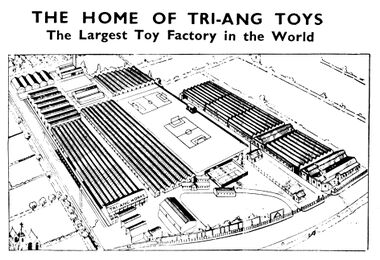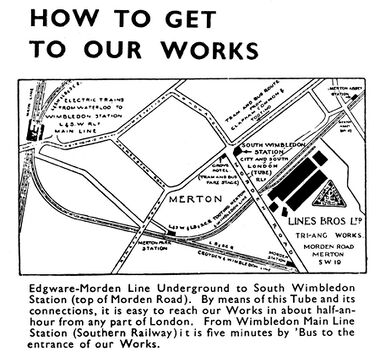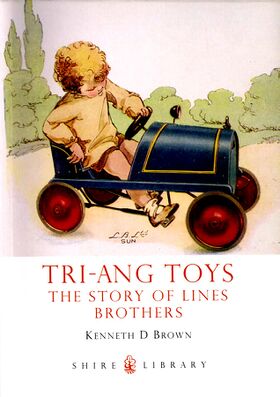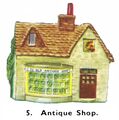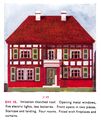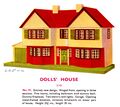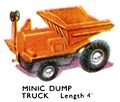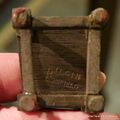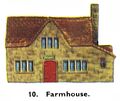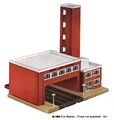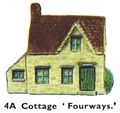Category:Tri-ang
| Toy Brands and Manufacturers |
|---|
Tri-ang |
| 1919 - 1971 |
1937: "The Home of Tri-ang Toys", "The Largest Toy Factory in the World" [image info]
1937: "How to get to our works" [image info]
1947: "Children always prefer Tri-ang Toys" [image info]
1948: Triang - The Toys for Healthy and Happy Recreation, Pedal Racer and Tricycle [image info]
"Tri-Ang Toys: The Story of Lines Brothers", by Kenneth D Brown (Shire Books) [image info]
The toymaking company Lines Brothers was founded by the brothers Walter, William and Arthur Lines when they returned to civilian life after WW1. The company used Tri-Ang as a brandname, since a triangle is made of three lines.
Lines Brothers became a behemoth of a company, at one time claimed to be the largest toy company on the World, and even absorbing Meccano Ltd. However, the traditional "Big Toy Company" business model began to become less reliable through the 1960s, and Lines Brothers Limited called in the administrators in ~1971.
Origins: G&J Lines
Toymaking had been something of a family tradition for the brothers - their father was Joseph Lines, who ran the toymaking company G&J Lines (1876-1930) with his brother George Lines, and the family had started making toys and models back in ~1850.
G&J's business had been wood-based, with a speciality being wooden horses in various scales, right up to full-size models used in shops to sell saddlery - looking for new markets for their wooden horses, G&J Lines had been successful in promoting the rocking-horse. However, while G&J were focused on traditional wooden toys (with some wheeled items), the brothers seemed impatient to move forwards into new markets. This was probably especially true of Walter Lines, who had shown real talent for almost everything to do with the industry, from toy design to factory layout. Walther is credited with having invented the scooter while at G&J, but been unable to persuade the company to put it into production. G&J did make wheeled items such as horse tricycles (a wooden horse with the mechanics of a tricycle embedded in it), but the idea that children might enjoy riding wheeled vehicles that didn't look like animals seems not to have struck G&J as sound or desirable.
Matters seem to have come to a head when the brothers returned from their service in World War One, where they'd have seen how early mechanisation was going to make horses obsolete on the battlefield. The comparison between the battlefield and the toy industry probably wasn't lost on them, and after a showdown with G&J, the brothers started their own toy company, Lines Brothers Limited, with Walter doing the initial toy design work.
Reintegration
LBL absorbed the products of G&J Lines after their father Joseph died in 1931.
While the Tri-ang brand had multiple sub-brands based around factories with their own particular products (such as International Model Aircraft, and Tri-ang Railways, the "heart" of the company always seemed to be the products descended from the G&J Lines range – when asked what they associate with the name Tri-ang, the company's main emotional impact on people's lives growing up seems to have been created by the pedalcars and tricycles, and perhaps (if parental income allowed it) memories of a Tri-ang dollhouse or rocking-horse in the nursery.
The Merton factory
The brothers set up their Triang Works in Morden Road, London SW10, billed as "The largest Toy Factory in the World", and designed by Walter.
The Merton site had its own railway siding, and, in the centre of the factory site, it's own football field, which also came in handy as a space for testing out the model aircraft produced by the brothers' "International Model Aircraft" company, which was on-site.
Expansion
As the business boomed, Lines Brothers were keen to continue entering new market sectors, and avoid the more blinkered example of G&J. Not committed to any particular approach to toymaking, Walter embarked on a programme of acquisitions – where other companies might tentatively make partnerships with outside companies, Walter would simply buy them outright. Walter was a fan of vertical integration – Lines Brothers used a lot of paint, so they bought a paint company. They used a lot of paper, so they bought a paper company, and forestry to grow their own trees.
Hamleys
When the London toy shop Hamleys went into receivership, Walter polled other toy manufacturers about what their attitude might be if LBL acquired the shop but continued to run it semi-independently ... after which Walter also had the country's biggest toyshop.
Rovex
LBL's agnostic approach to materials and technologies made it easier for them to avoid getting stuck in a rut. They bought Rovex, a small plastics moulding company in Richmond, and set them up with a new factory site in Margate, making plastic-bodies model railways as Triang Railways.
Spot-On
The company's Spot-On range were made at a new factory in Castleereagh, Northern Ireland.
Others
Overall, Lines Brothers at their peak were supposed to own over fifty companies in the UK and abroad, including manufacturing and assembly in Australia and Canada ("Thistle Toys").
Branding
Although the Triang brand was a brilliantly clever bit of marketing, the Lines Brothers approach to market branding was slightly haphazard, and coupled with their enthusiasm for taking over and founding new companies, a product might have as many as four different brandnames plastered over it. The "Penguin" Boats produced by International Model Aircraft (a subsidiary of Lines Brothers) were branded Lines Brothers, and Triang, and IMA and International Model Aircraft ... and FROG (Flies Right Off Ground, IMA's brand originally created for model aircraft ... and since the boats didn't fly, they were also branded Penguin, IMA's sub-brand of FROG for non-flying products.
The extent to which the brothers' enthusiasm for playing with branding wasn't matched by branding discipline was also apparent in the name Tri-ang ... more specifically, in the way that the company couldn't decide how the name was supposed to be written. Although the spelling appeared to be constant, adverts used almost every combination of capitalisation: TRI-ANG, Tri-ang, and Tri-Ang, and the brothers had even initially presented the brand as "Triang Tois" (with an "i" instead of a "y"). Luckily, the customers didn't seem to care.
Brandnames
Tri-ang Hornby logo, 1965 [image info]
With three founders, all of whom were brought up in the toymaking business, Lines Brothers' empire just kept growing. The range included the miniature clockwork Minic clockwork tinplate vehicles, larger-ride-on cars, tricycles, rocking-horses, dollhouses, FROG planes, Pedigree prams, Fairycycle bicycles, and Spot-On diecast vehicles as a more upmarket competitor to Dinky Toys.
With the takeover of Meccano Ltd in the mid-1960s, Triang also acquired Dinky, Meccano and Hornby (with Triang Railways rebranding as "Triang Hornby").
Lines Brothers in the 1960s - the final decade
The Sixties were a difficult time for the British toy industry, with domestic companies struggling to compete with imported toys from the US and Japan. When Meccano Ltd. went bust in the mid-1960s, Lines Brothers acquired them and integrated most of the products into their lineup, but by this time, some of the factors that had been damaging Meccano Ltd were also having an impact on LBL. Although LBL had done their best to move with the times, sturdy metal and wooden toys bought through toyshops with decent profit margins were being increasingly replaced with cheap mass-produced plastic, with the diecast car market increasingly dominated by cheaper imports from the likes of Mattel, and far eastern manufacturing taking over much of what had once been the "penny toys" sector. US toy companies were now often owned by large conglomerates with deep pockets like Quaker Oats and General Mills who wanted to diversify, and if their heavily-promoted product lines failed to create a long-term market, then by that time those companies were sold on, their competitors had already been damaged.
It was a time of buyouts and rationalisations and venture capital acquisitions, and Lines Brothers finally succumbed in ~1971, and was broken up.
See also:
External links
Subcategories
This category has the following 57 subcategories, out of 57 total.
+
- Lines Bros Inc (4 F)
A
- Arkitex (11 P, 36 F)
B
- Big Big Train (empty)
C
- Cotswold Village Series (15 F)
- Countryside Series (21 F)
E
- Eric Elgin (4 P, 1 F)
F
- FROG Penguin Model Aircraft Kits (4 P, 26 F)
I
J
- Jennys Home (5 P, 40 F)
- Jennys Home room box system (4 P, 23 F)
M
- Magicar Motoring (1 P, 1 F)
- Minic Clockwork Novelties (2 P, 12 F)
- Minic Electric Model Cars (1 F)
- Minic Motorways Fairground (3 F)
- Minic Motorways miscellaneous (12 F)
- Minic Motorways raceways (3 F)
- Minic Motorways vehicles (25 F)
- Minic Push And Go (7 F)
- Minic Ships, vessels (48 P, 23 F)
- Minic Vehicles (Second Series) (11 F)
N
P
- Penguin rubber-band vehicles (1 F)
- Pennybrix (2 P, 6 F)
- Period scale model dolls furniture (1 P, 42 F)
S
- Spot-On dollhouse fittings (5 P, 8 F)
T
- The Spot-On Collection (display) (8 P, 7 F)
- Tri-ang dollhouses (7 P, 32 F)
- Tri-ang Garages (1 P, 7 F)
- Tri-ang Lionel (3 F)
- Tri-ang Minic Ships (display) (62 P, 6 F)
- Tri-ang Railways TT (2 F)
- Tri-ang Real Estate (1 P, 6 F)
- Tri-ang Transcontinental (1 P, 4 F)
- Tri-ang water-going ships and boats (8 P, 14 F)
V
Pages in category ‘Tri-ang’
The following 200 pages are in this category, out of 211 total.
(previous page) (next page)+
A
- A-Class Submarine (Minic Ships 817)
- A-Class Submarine, reconstructed (Minic Ships 818)
- Ambulance 75M (Triang Minic)
- Ambulance Car (Triang Railways R248)
- Arkitex Construction Kit Set B (00-H0 scale)
- Arkitex Construction Kit Set D (00-H0 scale)
- Arkitex Construction Kit Set E (00-H0 scale)
- Arkitex Construction Kit Set No3 (1/42 scale)
- Arkitex Handbook and Catalogue
- Arkitex parts
- Army Van (Tri-ang Minic 21M CF)
- Avon 17" Ocean-going Cruiser (Tri-ang 432S)
B
- Beacon (Minic Ships 882)
- Bedford oil tanker truck (Spot-On)
- Blackburn Shark K4206 (FROG Penguin)
- Block of flats, four storey (Arkitex 00/H0 scale)
- Blue Pullman Train Set (Tri-ang RS52)
- BMW Isetta bubble-car, bright red, LTR 145 (Spot-On 118)
- BMW Isetta bubble-car, dark blue, JPO 113 (Spot-On 118)
- BMW Isetta bubble-car, dark red, LXQ 216 (Spot-On 118)
- BMW Isetta bubble-car, green, JPO 113 (Spot-On 118)
- BMW Isetta bubble-car, light mauve (Spot-On 118)
- BMW Isetta bubble-car, yellow, CMO 118 (Spot-On 118)
- Brake Van B950350 (Triang Wrenn W4310)
- Breakdown lorry 48M, postwar (Triang Minic)
- Breakdown lorry 48M, prewar (Triang Minic)
- British Light Vessel Cork (Minic Ships 737)
- British Light Vessel St Gowan (Minic Ships 738)
- British Trader, Coastal Steamer No1, clockwork (Tri-ang 2927)
- Bustler-Class Naval Tug (Minic Ships 810)
C
- Caravan, green, prewar (Triang Minic 16M)
- Caravan, red and cream, postwar (Triang Minic 16M)
- Caravan, red and stone, prewar (Triang Minic 16M)
- Caravanette, ~1930 (Triang)
- Carter Paterson and Pickfords Van (Tri-ang Minic 22M)
- Carter Paterson delivery van 22M (Triang Minic)
- Clockwork lifeboat (Tri-ang)
- Contemporary Large Panel Window (Tri-ang 1150)
- Contemporary Small Two-Light Window (Tri-ang 1153)
- Contemporary Three-Light Window with Opening Light (Tri-ang 1152)
- Contemporary Three-Light Window with Two Opening Lights (Tri-ang 1151)
- Cranes Unit (Minic Ships 837)
D
F
- Factory Unit (Minic Ships 853)
- Farm Tractor, post-war (Tri-ang Minic 83M)
- Fire Engine (Triang Minic 62ME)
- Floating Dock (Minic Ships 885)
- Ford Royal Mail Van (Triang Minic 3M)
- Ford £100 Saloon, blue, prewar (Tri-ang Minic 1M)
- Ford £100 Saloon, green, postwar (Tri-ang Minic 1M)
- Ford £100 Saloon, green, prewar (Tri-ang Minic 1M)
- FROG Interceptor Mark IV, boxed
- FROG mailplane, flying model (Triang)
G
H
- Harbour Models (Triang Minic)
- Hawker Hart K 5142 (FROG Penguin)
- Hawker Hind, unbuilt kit (FROG Penguin)
- HM Cruiser Superb (Minic Ships 762)
- HM Cruiser Swiftsure (Minic Ships 761)
- HM Yacht Britannia (Minic Ships 721)
- HMAS Anzac destroyer (Minic Ships 781)
- HMHS Britannia, Royal Yacht, hospital markings (Minic Ships 721H)
- HMS Alamein destroyer (Minic Ships 779)
- HMS Ashton minesweeper (Minic Ships 801)
- HMS Bulwark aircraft carrier (Minic Ships 751)
- HMS Bulwark aircraft carrier (Minic Ships, second issue)
- HMS Centaur aircraft carrier (Minic Ships 752)
- HMS Dainty destroyer (Minic Ships 773)
- HMS Daring destroyer (Minic Ships 771)
- HMS Decoy destroyer (Minic Ships 774)
- HMS Dufton minesweeper (Minic Ships 800)
- HMS Jutland destroyer (Minic Ships 780)
- HMS Torquay anti-submarine frigate (Minic Ships 792)
- HMS Upton minesweeper (Minic Ships 805)
- HMS Vanguard battleship (Minic Ships 741)
- HMS Vanguard battleship (Minic Ships, second issue)
- HMS Venus destroyer (Minic Ships 788)
- HMS Wiston minesweeper (Minic Ships 806)
J
- Jabberwock, clockwork (Triang Minic)
- Jack-In-A-Boat (Tri-ang Minic)
- Jacobean Chair (Eric Elgin)
- Jacobean Chairs (Elgin for Tri-ang)
- Jacobean Dining Table (Elgin for Tri-ang)
- Jacobean Dresser (Elgin for Tri-ang)
- Jeep 2068315-S (Tri-ang Minic 78M)
- Jennys Home Lighting Set
- Template:JennysHomeRoom
- Junior Yacht no000 (Triang)
L
- Large Room (Triang JR102)
- Learner's Car (Triang Minic 12M)
- Lifeboat Station (Minic Ships 861)
- Lifting Bridge (Minic Ships 846)
- Lighthouse (Minic Ships 878)
- Lighting Set (Arkitex KA-42-L)
- LMS Delivery Van (Triang Minic 80M)
- LMS open wooden wagon, M (Tri-Ang)
- LMS wooden goods wagon, M (Tri-Ang)
- LMS wooden locomotive M (Tri-Ang)
- LMS wooden locomotive size A (Tri-Ang)
- LNER Express Parcels Service Van BB 1374 (Triang Minic 81M)
- Lock Gates (Minic Ships 844)
- Luton Transport Van (Tri-ang Minic 24M)
M
- Massey-Harris-Ferguson MF65 Tractor (Spot-On 137)
- Massey-Harris-Ferguson MF65 Tractor, red mudguards (Spot-On 137)
- Mechanical Horse and Brewers Lorry with Barrels, Postwar (Triang Minic 72M)
- Mechanical Horse and Cable Trailer with Drums, postwar (Triang Minic 73M)
- Mechanical Horse and Milk Tank Trailer (Tri-ang Minic 71M)
- Mechanical horse and pantechnicon, postwar, grey (Triang Minic 30M)
- Mechanical Horse and Trailer with Cruiser, postwar, red (Triang Minic 114M)
- Minic Motor Rally Racing
- Minic Motorways sets
- Model garage L172B (Spot-On)
- MS British Adventurer (Tri-ang)
- Multi Purpose Stairway Kit (Arkitex KA-42-S)
O
P
- Penguin Series 4 long range clockwork Cabin Cruiser (Tri-ang 423S)
- Periwinkle Pennybrix, figure
- Pier Centre Section (Minic Ships 847)
- Pier Entrance Section (Minic Ships 848)
- Pier with dancehall (Minic Ships)
- Police Box L151 (Spot-On)
- Princess Elizabeth's Dolls House (Tri-Ang 3146)
- PS Britannia paddle steamer (Minic Ships 728)
- PS Cardiff Queen paddle steamer (Minic Ships 730)
R
- Red Double Decker No14 Bus, Military Pickle (Triang Minic)
- Red Double Decker No14 Bus, Pedigree Dolls (Triang Minic)
- Red Double Decker No14 Bus, Penguin (Triang Minic)
- Red Double Decker No177 Bus, Ovaltine (Triang Minic)
- Red Double Decker No177 Bus, Ovaltine, pre-war (Triang Minic)
- Red Double Decker No177 Bus, Triang Pedal Motors (Triang Minic)
- RMS Aquitania ocean liner (Minic Ships 705)
- RMS Canberra ocean liner (Minic Ships)
- RMS Caronia cruiser (Minic Ships 701)
- RMS Queen Elizabeth ocean liner (Minic Ships 702)
- RMS Queen Elizabeth Presentation Set (Minic Ships M891)
- RMS Queen Mary ocean liner (Minic Ships 703)
- RMS Saxonia ocean liner (Minic Ships 708)
- Rolls Type Sedanca (Triang Minic 42M)
- Rolls Type Sedanca, prewar, pale pink, electric lights (Triang Minic 42ME)
- Rolls Type Sunshine Saloon (Tri-ang Minic 45M)
- RouteMaster double-decker bus (Spot-On)
- Royal Navy Carrier Task Group Presentation Set (Minic Ships M893)
S
- Scharnhorst battlecruiser (Minic Ships, second edition)
- Sea Plastic (Minic Ships 857 858)
- Searchlight (FROG Penguin)
- Searchlight Lorry (Tri-ang Minic 49ME)
- Shutter Van, postwar (Triang Minic 103M)
- Slide-front Dollhouse (Tri-ang 65)
- Small Room (Triang JR101)
- Southern Railway delivery van 82M (Triang Minic)
- Sports Saloon (Tri-ang Minic 4M)
- SS Nieuw Amsterdam ocean liner (Minic Ships 706)
- SS United States ocean liner (Minic Ships 704)
- SS United States Presentation Set (Minic Ships M892)
- SS Varicella Shell oil tanker (Minic Ships 732)
- Statue of Liberty (Minic Ships 884)
- Steamroller 33M, postwar (Triang Minic)
- Steamroller 33M, prewar (Triang Minic)
- Storage Tanks Unit (Minic Ships 838)
T
- Tanker Wharf Berth (Minic Ships 855)
- Tanker Wharf Straight (Minic Ships 854)
- Taxi, postwar, blue (Triang Minic 35M)
- Taxi, prewar, blue (Triang Minic 39M)
- Taxi, prewar, dark green (Triang Minic 39M)
- Taxi, prewar, grey (Triang Minic 39M)
- Taxi, prewar, light green (Triang Minic 39M)
- Taxi, prewar, red (Triang Minic 39M)
- Taxis, postwar, blue (Triang Minic 35M)
- Thames Clockwork 14" Cabin Cruiser (Tri-ang 413-S)
- Tip lorry 23M (Triang Minic)
- Tourer With Passengers (Tri-ang Minic 34M)
- Town Coupé (Tri-ang Minic 7M)
- Town Coupé, blue (Tri-ang Minic 7M)
- Traction engine, postwar (Triang Minic 44M 54M)
- Traffic Control Car (Tri-ang Minic 29M)
- Transcontinental train set (TriangRailways RS-13)
- Tri-Ang Minic Ships display
- Tri-ang Transport Van, prewar (Tri-ang Minic 21M)
- Triang Stockbroker Dollhouse, no72 no93, restoration (Jen Spencer)
- TSS Vikingen whaling factory ship (Minic Ships 733)
- Tugboat (Minic Ships 731)
- Tugboat Annie, Thames Tug (Tri-ang Penguin 428S)
- Two-storey House with Garage (Pennybrix)
Media in category ‘Tri-ang’
The following 200 files are in this category, out of 846 total.
(previous page) (next page)- 3-4 Left Hand Shop Window, No 73 (ArkitexCat 1961).jpg 1,177 × 1,445; 140 KB
- 3-4 Right Hand Shop Window, No 73 (ArkitexCat 1961).jpg 1,139 × 1,439; 138 KB
- 9-Hole and 3-Hole Bases (ArkitexCat 1961).jpg 1,669 × 1,553; 203 KB
- A-Class Submarines, Minic Ships M817, M818 (MinicShips 1960).jpg 3,000 × 1,181; 684 KB
- Accessories, Model-Land RML8 (TriangRailways 1964).jpg 1,568 × 1,049; 452 KB
- AEC Mammoth Major 8, with flat float with sides, Spot-On Models 110-3 (SpotOn 1959).jpg 2,272 × 1,070; 704 KB
- AEC Mammoth Major 8, with flat float, Spot-On Models 110-2 (SpotOn 1959).jpg 2,207 × 1,017; 571 KB
- Aircraft Carriers Bulwark, Centaur, Albion, Minic Ships M751-M753 (MinicShips 1960).jpg 3,000 × 1,337; 1.04 MB
- Airspeed Envoy, FROG Penguin (MM 1937-10).jpg 1,600 × 829; 149 KB
- Always Buy Jennys Home Furniture, side panel, packaging (Tri-ang JR101).jpg 1,200 × 830; 128 KB
- Always Buy Jennys Home Furniture, side panel, packaging (Tri-ang JR102).jpg 1,200 × 638; 120 KB
- Ambulance Car R248, Triang Railways (TRCat 1965).jpg 2,907 × 1,815; 572 KB
- Ambulance, Triang Minic (MinicCat 1950).jpg 1,032 × 755; 298 KB
- Antique Shop, Cotswold Village No5 (SpotOnCat 1stEd).jpg 796 × 806; 121 KB
- Area 01c.JPG 1,024 × 768; 463 KB
- Arkitex Catalogue and Handbook, front cover, 1-42 and 00 (ArkCat 1961).jpg 3,000 × 1,987; 825 KB
- Armoured Car, Minic No2 (MinicStripCat 1950).jpg 1,169 × 966; 422 KB
- Armstrong Scimitar, FROG Penguin (MM 1937-10).jpg 1,600 × 1,108; 156 KB
- Armstrong Siddeley Sapphire 236, Spot-On Models 101 (SpotOn 1959).jpg 2,277 × 1,213; 743 KB
- Aston Martin DB3, Spot-On Models 113 (SpotOn 1959).jpg 2,123 × 1,029; 549 KB
- Aston Martin DB4 GT, Minic Motorways M1573 (TriangRailways 1964).jpg 1,793 × 885; 568 KB
- Austin A40 Van, Triang Minic (MinicCat 1950).jpg 789 × 543; 184 KB
- Austin A40, Minic Motorways M1557 (TriangRailways 1964).jpg 1,390 × 877; 444 KB
- Austin A40, Triang Minic (MinicCat 1950).jpg 839 × 507; 175 KB
- Austin Healey 100-Six, Spot-On Models 105 (SpotOn 1959).jpg 1,879 × 940; 440 KB
- Automatic Cross-Roads Set, Minic Motorways M1623 (TriangRailways 1964).jpg 2,000 × 1,778; 905 KB
- Avon 17-inch electric Ocean-going Cruiser (Tri-ang 432S).jpg 1,600 × 901; 647 KB
- Avon 17-inch electric Ocean-going Cruiser, detail.jpg 1,600 × 1,067; 701 KB
- Avon Ocean-going Cruiser, Tri-ang 432S (BLCat 1962).jpg 1,328 × 879; 208 KB
- Avro 504E, FROG Penguin (MM 1937-10).jpg 1,600 × 663; 96 KB
- Barn, Cotswold Village No8 (SpotOnCat 1stEd).jpg 797 × 458; 73 KB
- Barn, Triang Countryside Series R365 (TRCat 1961).jpg 1,233 × 950; 565 KB
- Bathroom JH5, Jennys Home (Hobbies 1967).jpg 1,600 × 1,261; 193 KB
- Battle-Class Destroyers, Minic Ships M779-M782 (MinicShips 1960).jpg 3,000 × 1,506; 1.21 MB
- Beacon, Minic Ships M882 (MinicShips 1960).jpg 1,189 × 1,146; 355 KB
- Bedford Lorry with Bale Load, Minic Motorways M1546 (TriangRailways 1964).jpg 1,800 × 1,079; 802 KB
- Bedroom JH3, Jennys Home (Hobbies 1967).jpg 1,540 × 1,338; 313 KB
- Bend, Outer, 45deg, Minic Motorways M1616 (TriangRailways 1964).jpg 1,772 × 915; 504 KB
- Bend, Single Track, 45deg, Minic Motorways M1617 (TriangRailways 1964).jpg 1,280 × 677; 278 KB
- Bend, Standard 30deg, Minic Motorways M1615 (TriangRailways 1964).jpg 768 × 688; 195 KB
- Bend, Standard, 45deg, Minic Motorways M1613 (TriangRailways 1964).jpg 1,077 × 706; 275 KB
- Bend, Standard, 90deg, Minic Motorways M1611 (TriangRailways 1964).jpg 1,748 × 789; 470 KB
- Bentley Four-Door Sports Saloon, Spot-On Models 102 (SpotOn 1959).jpg 2,506 × 1,191; 857 KB
- Bentley Tourer, Triang Minic (MinicCat 1950).jpg 985 × 587; 215 KB
- Bermuda Bungalow, Model-Land RML12 (TriangRailways 1964).jpg 1,750 × 910; 811 KB
- Bermuda Bungalow, semi-built, Model-Land RML21 (TriangRailways 1964).jpg 1,383 × 923; 678 KB
- Blackburn Shark, FROG Penguin (MM 1937-10).jpg 1,600 × 683; 120 KB
- Block of Flats (Tri-ang Jennys Home).jpg 2,335 × 1,229; 492 KB
- Blue Pullman Diesel Motor Cars, powered and unpowered, R-555 and R-556 (TR 1963).jpg 3,000 × 1,166; 1.58 MB
- Blue Pullman Parlour Car, Tri-ang R-426 (TR 1964).jpg 2,467 × 904; 972 KB
- Blue Pullman Train Set, Tri-ang RS-52 (TR 1964).jpg 4,592 × 1,431; 2.79 MB
- BMW Isetta, Spot-On Models 118 (SpotOn 1959).jpg 1,271 × 969; 342 KB
- Boiler House and Chimney, Model-Land RML27 (TriangRailways 1964).jpg 1,603 × 2,398; 1.23 MB
- Bomb Transporter R239, Triang Railways (TRCat 1963).jpg 1,600 × 729; 193 KB
- Breakdown Lorry with Mechanical Crane, Minic 2860 (TriangCat 1937).jpg 1,273 × 910; 200 KB
- Breakdown Lorry with Mechanical Crane, Triang Minic (MinicCat 1937).jpg 1,040 × 740; 159 KB
- Breakdown Lorry, Minic (MM 1940-07).jpg 1,168 × 861; 117 KB
- Breakdown Lorry, Minic 48M (1939).jpg 609 × 395; 40 KB
- Breakdown Lorry, Minic Motorways M1565 (TriangRailways 1964).jpg 1,617 × 1,189; 663 KB
- Breakdown Lorry, Triang Minic (MinicCat 1950).jpg 963 × 766; 272 KB
- Breakwater Angle Section, Left, Minic Ships M828L (MinicShips 1960).jpg 1,475 × 1,137; 343 KB
- Breakwater Angle Section, Right, Minic Ships M828R (MinicShips 1960).jpg 1,499 × 1,107; 332 KB
- Breakwater End Section, Minic Ships M829 (MinicShips 1960).jpg 1,350 × 1,006; 304 KB
- Breakwater, Straight, Minic Ships M827 (MinicShips 1960).jpg 3,000 × 765; 591 KB
- Bristol Blenheim, FROG Penguin (MM 1939-12).jpg 1,600 × 732; 118 KB
- British Locomotives, Triang Railways (TRCat 1956).jpg 1,600 × 1,237; 623 KB
- British Railways Van, Model-Land RML81 (TriangRailways 1964).jpg 1,118 × 898; 447 KB
- British Railways Van, Triang Minic (MinicCat 1950).jpg 956 × 658; 283 KB
- Broom Cupboard and Electric Cleaner JH38, Jennys Home (Hobbies 1967).jpg 1,066 × 1,534; 257 KB
- Bungalow with automatic garage, Minic Motorways M1806 M1807 (TriangRailways 1964).jpg 2,000 × 1,442; 1.03 MB
- Bus Garage, Minic Motorways M1803 (TriangRailways 1964).jpg 2,000 × 1,543; 1.51 MB
- Bustler-Class Fleet Tug, Minic Ships M810 (MinicShips 1960).jpg 2,726 × 1,280; 877 KB
- Buy It Room By Room, top panel, packaging (Tri-ang JR101).jpg 2,200 × 1,489; 538 KB
- Buy It Room By Room, top panel, packaging (Tri-ang JR102).jpg 2,200 × 1,622; 638 KB
- Cabriolet, Triang Minic (MinicCat 1937).jpg 1,040 × 740; 153 KB
- Cabriolet, Triang Minic (MM 1935-06).jpg 780 × 513; 99 KB
- Canvas Tilt Lorry, Minic (MM 1940-07).jpg 1,327 × 931; 153 KB
- Canvas Tilt Lorry, Minic 69M.jpg 626 × 413; 45 KB
- Car and Caravan, Triang Minic (MinicCat 1950).jpg 1,585 × 741; 406 KB
- Car Transporter, Minic Motorways M1548 (TriangRailways 1964).jpg 1,946 × 1,425; 1.04 MB
- Car Water Ferry Loading Quay, Minic Motorways M1579 (TriangRailways 1964).jpg 2,000 × 1,118; 791 KB
- Car Water Ferry Set, Minic Motorways M1580 (TriangRailways 1964).jpg 1,982 × 804; 512 KB
- Car Water Ferry, Minic Motorways M1578 (TriangRailways 1964).jpg 1,933 × 1,046; 621 KB
- Caravan (non-electric). and Limousine, Minic 2833 2855 (TriangCat 1937).jpg 1,785 × 837; 254 KB
- Caravan Set, Triang Minic (MinicCat 1937).jpg 2,080 × 740; 335 KB
- Caravan, Minic Motorways M1553 (TriangRailways 1964).jpg 1,277 × 953; 482 KB
- Carter Paterson and Co Van, Minic 2838 (TriangCat 1937).jpg 1,261 × 789; 217 KB
- Carter Paterson and Pickfords Removals Lorry, clockwork (Triang Minic).jpg 1,024 × 768; 453 KB
- Carter Paterson Moving Van, Triang Minic (MinicCat 1937).jpg 1,040 × 740; 154 KB
- Checkpoint Bravo Rally Set, Minic Rally Racing (MM 1966-12).jpg 1,209 × 1,600; 312 KB
- Children always prefer Tri-ang Toys (MM 1947-07).jpg 1,734 × 2,500; 472 KB
- Children Figures Set No3, Model-Land RML72 (TriangRailways 1964).jpg 1,536 × 536; 224 KB
- Church, Cotswold Village No13 (SpotOnCat 1stEd).jpg 948 × 997; 160 KB
- Church, Triang Countryside Series R361 (TRCat 1961).jpg 1,360 × 1,544; 873 KB
- CKD Completely Knocked Down kits, Triang Railways (TRCat 1963).jpg 1,705 × 2,200; 869 KB
- Clockwork Pennybrix sets A250 A350 (RovexTC 1970).jpg 1,570 × 2,000; 2.21 MB
- Coach, Minic Motorways M1544 (TriangRailways 1964).jpg 1,869 × 1,016; 796 KB
- Coal Dump, Triang Countryside Series R373 (TRCat 1961).jpg 1,018 × 806; 363 KB
- Coastal Steamer No1, British Trader, 2927 (TriangCat 1937).jpg 1,386 × 1,669; 350 KB
- Coniston-Class Coastal Minesweepers, Minic Ships M799-806 (MinicShips 1960).jpg 2,874 × 1,862; 956 KB
- Conqueror Tank, Minic Motorways M1569 (TriangRailways 1964).jpg 1,797 × 974; 607 KB
- Container Lorry, Minic Push And Go range (MM 1954-07).jpg 1,656 × 1,098; 375 KB
- Contemporary Double Door (Tri-ang 1148).jpg 1,640 × 2,000; 517 KB
- Contemporary Front Door, centre (Tri-ang 1147).JPG 2,000 × 1,286; 401 KB
- Contemporary Internal Door (Tri-ang 1149).jpg 1,201 × 2,000; 477 KB
- Contemporary Large Panel Window (Tri-ang 1150).jpg 2,000 × 1,350; 393 KB
- Contemporary Small Two-Light Window (Tri-ang 1153).jpg 2,000 × 783; 150 KB
- Contemporary Three-Light Window with Opening Light (Tri-ang 1152).jpg 2,000 × 1,331; 227 KB
- Contemporary Three-Light Window with Two Opening Lights (Tri-ang 1151).jpg 2,000 × 798; 203 KB
- Contemporary Windows and Doors range (Tri-ang).jpg 2,000 × 1,538; 380 KB
- Cornerstones Cottage, Cotswold Village No3 (SpotOnCat 1stEd).jpg 618 × 814; 94 KB
- Countryside Accessory Pack, Triang Countryside Series R376 (TRCat 1961).jpg 2,059 × 1,082; 459 KB
- Cranes Unit, Minic Ships M837 (MinicShips 1960).jpg 2,364 × 1,925; 863 KB
- Cross-Channel twin-turbine ship, Minic Ships 722, 723, 724 (MinicShips 1960).jpg 3,000 × 1,519; 1,018 KB
- Cross-Roads, 90deg, Minic Motorways M1623 (TriangRailways 1964).jpg 1,303 × 1,066; 489 KB
- Customs Shed, Minic Ships M839 (MinicShips 1960).jpg 1,704 × 1,224; 668 KB
- D-Class Destroyers, Minic Ships M771-M774 (MinicShips 1960).jpg 3,000 × 1,499; 1.24 MB
- Daimler saloon, Minic 46M, 1939.jpg 531 × 395; 41 KB
- Daimler Sunshine Saloon, Triang Minic (MinicCat 1950).jpg 977 × 608; 93 KB
- Daimler Type Sedanca, Triang Minic (MinicCat 1937).jpg 1,040 × 740; 151 KB
- Daimler Type Tourer, Triang Minic (MinicCat 1937).jpg 1,040 × 740; 153 KB
- Daimler-type Sedanca, Minic 2859 2863 (TriangCat 1937).jpg 1,037 × 911; 160 KB
- Daimler-type Tourer, Minic 2853 (TriangCat 1937).jpg 1,077 × 740; 150 KB
- De-Havilland Trident airliner, Model-Land RML52 (TriangRailways 1964).jpg 4,178 × 1,985; 1.88 MB
- Delivery Lorry, Minic 2834 (TriangCat 1937).jpg 1,049 × 638; 140 KB
- Derwent Cabin Cruiser, Tri-ang 414S (BLCat 1962).jpg 1,255 × 870; 187 KB
- Destroyer Kits, FROG (MM 1960-03).jpg 1,535 × 2,200; 1,007 KB
- Dining Room JH1, Jennys Home (Hobbies 1967).jpg 1,540 × 1,311; 308 KB
- Dinky Marvels in Miniature (LBInc ~1964).jpg 3,000 × 1,353; 672 KB
- Dinky Models logo (~1964).jpg 3,000 × 939; 101 KB
- Dollhouse furniture being sorted, mostly by Spot-On.jpg 2,000 × 1,126; 1.39 MB
- Dolls House No10, Tri-ang 3149 (TriangCat 1937).jpg 1,985 × 2,365; 923 KB
- Dolls House No12, Tri-ang 3150 (TriangCat 1937).jpg 2,933 × 2,773; 1.65 MB
- Dolls House No20, Tri-ang 3129 (TriangCat 1937).jpg 1,690 × 2,006; 464 KB
- Dolls House No21, Tri-ang 3130 (TriangCat 1937).jpg 1,657 × 2,117; 488 KB
- Dolls House No22, Tri-ang 3131 (TriangCat 1937).jpg 1,721 × 2,241; 656 KB
- Dolls House No23, Tri-ang 3132 (TriangCat 1937).jpg 1,471 × 1,913; 477 KB
- Dolls House No24, Tri-ang 3133 (TriangCat 1937).jpg 1,798 × 2,280; 738 KB
- Dolls House No45, Tri-ang 3134 (TriangCat 1937).jpg 2,227 × 2,061; 759 KB
- Dolls House No49, Ultra Modern, Tri-ang 3135 (TriangCat 1937).jpg 1,301 × 1,480; 338 KB
- Dolls House No50, Ultra Modern, Tri-ang 3136 (TriangCat 1937).jpg 1,743 × 1,613; 420 KB
- Dolls House No51, Ultra Modern, Tri-ang 3137 (TriangCat 1937).jpg 1,969 × 1,477; 454 KB
- Dolls House No52, Ultra Modern, Tri-ang 3138 (TriangCat 1937).jpg 2,146 × 1,726; 621 KB
- Dolls House No53, Ultra Modern, Tri-ang 3139 (TriangCat 1937).jpg 2,489 × 1,802; 751 KB
- Dolls House No60 Tri-ang 3140 (TriangCat 1937).jpg 2,826 × 2,060; 863 KB
- Dolls House No61 Tri-ang 3141 (TriangCat 1937).jpg 3,241 × 2,131; 1.1 MB
- Dolls House No80, Large Country House, Tri-ang 3148 (TriangCat 1937).jpg 2,344 × 2,545; 1.02 MB
- Dolls House No91, Tri-ang 3143 (TriangCat 1937).jpg 2,898 × 2,594; 1.07 MB
- Dolls House No92, Tri-ang 3144 (TriangCat 1937).jpg 2,185 × 2,651; 904 KB
- Dolls House No93, Tudor Stockbroker Tri-ang 3145 (TriangCat 1937).jpg 4,771 × 2,171; 1.84 MB
- Double Deck Bus, London Transport, Triang Minic (MinicCat 1937).jpg 1,040 × 740; 180 KB
- Double Decker Bus, Minic Motorways M1545 (TriangRailways 1964).jpg 1,716 × 1,281; 1,009 KB
- Double Straight, Standard, Minic Motorways M1609 (TriangRailways 1964).jpg 2,261 × 1,165; 711 KB
- Double-deck Bus, Minic 2866 (TriangCat 1937).jpg 1,331 × 1,012; 304 KB
- Double-Decker Bus, large, Tri-ang.jpg 1,600 × 897; 971 KB
- Dove Cottage, box art (Triang Real Estate 5).jpg 1,525 × 1,600; 210 KB
- Dove Cottage, Model-Land RML5 (TriangRailways 1964).jpg 987 × 962; 425 KB
- Dump Truck, Triang Minic (MinicCat 1950).jpg 829 × 706; 103 KB
- Dust Cart, Minic 2849 (TriangCat 1937).jpg 1,221 × 729; 180 KB
- Dust Cart, Triang Minic (MinicCat 1937).jpg 1,040 × 740; 148 KB
- Dust Cart, Triang Minic (MinicCat 1950).jpg 975 × 583; 92 KB
- E-Type Jaguar, Minic Motorways M1559 (TriangRailways 1964).jpg 1,701 × 952; 514 KB
- ERF 68G, with brick load, Spot-On Models 109-2B (SpotOn 1959).jpg 2,211 × 1,001; 751 KB
- ERF 68G, with flat float with sides, Spot-On Models 109-3 (SpotOn 1959).jpg 2,245 × 991; 643 KB
- ERF 68G, with flat float, Spot-On Models 109-2 (SpotOn 1959).jpg 2,264 × 1,019; 545 KB
- Eric Elgin, Enfield, dollhouse furniture makers mark.jpg 1,800 × 1,797; 1.57 MB
- Exploding Car R249, Triang Railways (TRCat 1963).jpg 1,600 × 1,040; 319 KB
- Factory, Model-Land RML59 (TriangRailways 1964).jpg 2,726 × 1,864; 1.53 MB
- Factory, Triang Countryside Series R371 (TRCat 1961).jpg 1,459 × 1,000; 691 KB
- Fairey Battle, FROG Penguin (MM 1939-02).jpg 1,600 × 775; 127 KB
- Farm Cottage, Triang Countryside Series R370 (TRCat 1961).jpg 1,128 × 1,102; 560 KB
- Farm Tractor, box (Tri-ang Minic 83M).jpg 1,800 × 1,204; 428 KB
- Farm Tractor, clockwork (Tri-ang Minic 83M).jpg 1,200 × 819; 196 KB
- Farm Tractor, Triang Minic (MinicCat 1950).jpg 759 × 679; 83 KB
- Farmhouse, Cotswold Village No10 (SpotOnCat 1stEd).jpg 838 × 706; 119 KB
- Filling Station, Minic Motorways M1801 (TriangRailways 1964).jpg 2,000 × 1,111; 980 KB
- Fire Engine with electric headlight and battery, Minic 2867 (TriangCat 1937).jpg 1,201 × 791; 189 KB
- Fire Engine with Flashing Light, Minic Motorways M1550 (TriangRailways 1964).jpg 1,618 × 977; 700 KB
- Fire Engine, Minic 62M (1939).jpg 642 × 425; 52 KB
- Fire Engine, Triang Minic (MinicCat 1937).jpg 1,040 × 740; 156 KB
- Fire Station, Minic Motorways M1804 (TriangRailways 1964).jpg 1,899 × 2,000; 1.38 MB
- Floating Dock, Minic Ships M885 (MinicShips 1960).jpg 3,000 × 1,183; 1.19 MB
- Ford Light Van, Minic 2823 (TriangCat 1937).jpg 765 × 588; 102 KB
- Ford Light Van, Triang Minic (MinicCat 1937).jpg 1,040 × 740; 154 KB
- Ford Royal Mail Van, Minic 2822 (TriangCat 1937).jpg 764 × 573; 90 KB
- Ford Royal Mail Van, Triang Minic (MinicCat 1937).jpg 1,040 × 740; 149 KB
- Ford Zodiac, Spot-On Models 100 (SpotOn 1959).jpg 2,248 × 1,021; 565 KB
- Ford £100 Saloon, Minic 2821 (TriangCat 1937).jpg 762 × 552; 94 KB
- Ford £100 Saloon, Triang Minic (MinicCat 1937).jpg 1,040 × 740; 154 KB
- Forge, Triang Countryside Series R363 (TRCat 1961).jpg 1,196 × 974; 467 KB
- Four-Rocket Launcher R343, Triang Railways (TRCat 1963).jpg 1,600 × 1,079; 287 KB
- Fourways Cottage, Cotswold Village No4A (SpotOnCat 1stEd).jpg 700 × 661; 90 KB
- Freight wagon 22831, yellow (Triang Railways R.114).JPG 1,200 × 800; 436 KB
- FROG (MM 1935-06).jpg 1,621 × 2,119; 484 KB

